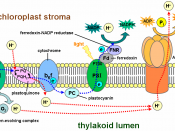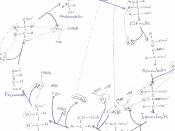Photosynthesis and Cellular Respiration
part one, Photosynthesis
Photosynthesis is when plants use the sun to create usable forms of energy. First I will explain the light reaction which takes place in the chloroplast. When light is absorbed by the chlorophyl, an electron is excited to a higher energy level in the chlorophyl and is captured by the primary acceptor. The oxidized chlorophyl is now a very strong oxidizing agent and there is a "space" left where the electron used to be. An enzyme then takes electrons from water to replace the electron lost. This reaction splits a water molecule into two hydrogen ions and one oxygen atom. The oxygen atom immediately joins another oxygen atom to form O2 and this is where oxygen is released. The photoexcited electrons that were in the primary acceptor then move on to the next photosystem by using the electron transport chain. As electrons go down the chain, their exergonic "falls" to a lower energy level and is harnessed by the thylakoid membrane to produce ATP.
This is called photophosphorylation because it's driven by light energy. When the electron reaches the "bottom" of the chain, it fills the "space" that was made in that photosystem when the light energy drove the electron to it's primary acceptor. The next primary acceptor passes the photoexcited electrons to a second electron transport chain, which transmits them to ferredoxin (Fd). Then an enzyme called NADP reductase transfers the electrons from Fd to NADP . This is the redox reaction which stores high energy electrons in NADPH, the molecule that provides reducing power for the synthesis of sugar in the calvin cycle, which I will talk about next.
The first part of the Calvin cycle is carbon fixation. The Calvin cycle uses each CO2 molecule by attaching it to a...



A bit brief
needs an introduction, needs what the processes are used for, but good none the less
0 out of 0 people found this comment useful.